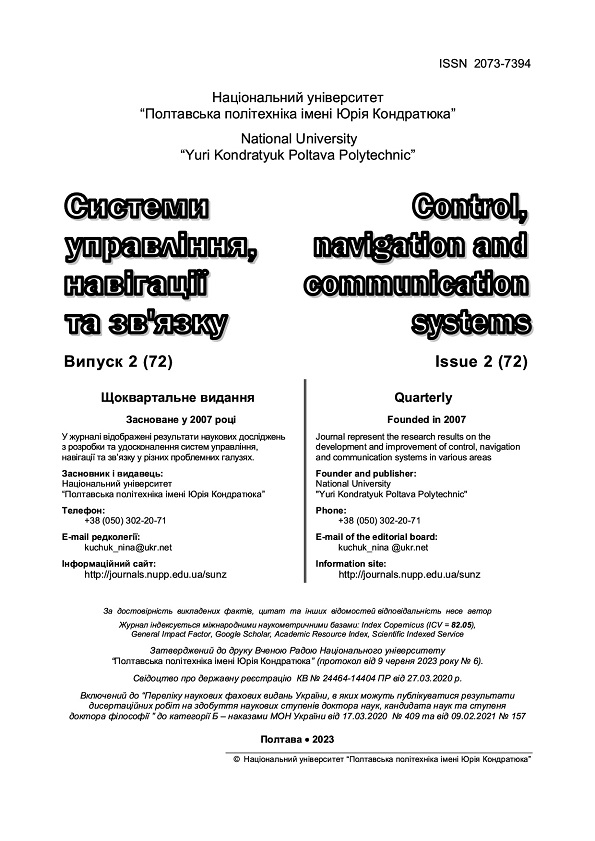ENHANCEMENT OF ENERGY SAVING OF WIRELESS SENSOR NETWORKS USING MACHINE LEARNING METHODS
DOI:
https://doi.org/10.26906/SUNZ.2023.2.092Keywords:
energy saving, wireless sensor network, node, machine learning, decision tree, classificationAbstract
Topicality. Wireless sensor networks (WSN) are a promising branch of computer network development. The key idea of BSM is to automate the collection of information about the environment and controlled objects. WSN is especially useful where the presence of a person in the controlled area is impossible or the collection of information must be carried out for a long time. BSMs became widespread after the active development of modern microelectronics, wireless communication technologies and corresponding hardware. The goal of this work is the development and analysis of algorithms for increasing energy saving in wireless sensor networks using machine learning methods. The object of research is the duration of the operation of a node in a wireless sensor network. The subject of research is algorithms for increasing energy saving. The subject of research is algorithms for increasing energy saving. Results. In this paper, a method of simulation modeling of computer network traffic with fractal properties is proposed. The theory of fractal analysis and the theory of Markov processes were used to generate traffic. This method can be part of a software simulation model of a computer network, which in turn can be used for testing network algorithms and protocols. Conclusions. Algorithms for the operation of the WSN sensor and the construction of a binary decision tree have been developed, which can be used to increase the energy saving of the functioning of nodes in wireless sensor networks. Methods of machine learning are considered. They allow you to operate with a lot of structured data, obtaining knowledge from them in the form of a model that can be used in the future to make a decision. The decision tree method was chosen to implement the proposed algorithm. The choice is due to the fact that this method has a high interpretation and is similar to the process of decision-making by the operator. In addition, decision trees allow classification with gaps in the input data, which can happen quite often in sensor networks. Based on the idempotency of the predicates of the decision tree, it is proposed to reduce the number of communication sessions due to the dynamic determination of the transmission frequency. Thus, this approach will make it possible to get rid of the constant transmission of data through a wireless communication channel, thereby saving energy resources of network nodes.Downloads
References
Akyildiz, I. F., Weilian, S. A survey on sensor networks // IEEE Communications magazine. 2002. 40(8). P. 102–114. doi:10.1109/MCOM.2002.1024422.
Abbas, I., Liu, J., Faheem, M., Noor, R. S. Different sensor based intelligent spraying systems in Agriculture // Sensors and Actuators A: Physical. 2020. Volume 316. P. 1–16.
Alias, F., Carrie, J. C., Alsina-Pages, R. WASN-Based day–night characterization of urban anomalous noise events in narrow and wide streets // Sensors. 2020. 20(17) 26 p.
Chen, Y., Nasser, N. Energy-balancing multipath routing protocol for wireless sensor networks // Quality of service in heterogeneous wired/wireless networks. New York: Qshine, 2006. Vol. 21. – P. 245–249. doi: 10.1145/1185373.1185401.
Das, K., Behera, R. N. A survey on machine learning: concept, algorithms and applications // International Journal of Innovative Research in Computer and Communication Engineering. 2017. 5(2). P. 1301–1309.
Gao, T., Greenspan, D., Welsh, M., Juang, R. R., Alm, A. Vital signs monitoring and patient tracking over a wireless network // Proceedings of the 27th IEEE EMBS Annual International Conference. 2005. P. 66–74.
Huang, J.H., Amjad, S., Mishra, S. CenWits: A sensor-based loosely coupled search and rescue system using witnesses // Proceedings of the Third Int. Conf. on Embedded Networked Sensor Systems (Sensys), San Diego, CA. 2005. P. 180–191.
Monitoring volcanic eruptions with a wireless sensor network / Werner-Allen, G., Johnson, J., Ruiz, M., Lees, J., Welsh, M. // Proceeedings of the Second European Workshop on Wireless Sensor Networks, IEEE. Istanbul, 2005. 13 p.
Hardware design experiences in ZebraNet / Zhang, P., Sadler, C. M., Lyon, S. A., Martonosi, M. // Proceedings of the SenSys'04, Baltimore, MD. 2004. P. 227–238. Li Q.-L. (2016), “Nonlinear Markov processes in large networks”, Special Matrices, Vol. 4(1), doi: https://doi.org/10.1515/spma-2016-0019
Yick, J., Mukherjee, B., Ghosal, D. Analysis of a Prediction-based Mobility Adaptive Tracking Algorithm // Proceedings of the IEEE Second International Conference on Broadband Networks (BROADNETS), Boston. 2005. Vol. 1. P. 753–760
Yu, Z., Tsai J. J., Weigert T. An automatically tuning intrusion detection system // IEEE Transactions on Systems, Man, and Cybernetics, Part B (Cybernetics). 2007. 37(2). P. 373–384.
Design considerations for solar energy harvesting wireless embedded systems / Raghunathan, V., Kansai, A., Hse, J., Friedman, J., Srivastava, M. // Proceedings of the IPSN. 2005. P. 457–462.
Second Generation System-on-Chip Solution for 2.4 GHz IEEE 802.15.4 / RF4CE ZigBee [Electronic resource] // Texas Instruments. Available at: http://www.ti.com/lit/ds/symlink/cc2530.pdf/. 05.05.2023. 36 p
Pelckmans, K., Jos, D. B., Johan, A. S., Bart, D. M. Handling missing values in support vector machine classifiers // Neural Networks 18. 2005. №5-6. P. 684–692
Venkatesan, R., Meng, J. E. A novel progressive learning technique for multi-class classification // Neurocomputing. 2016.207. P. 310–321.
Yu, Z., Tsai, J. J. P. A Framework of Machine Learning Based Intrusion Detection for Wireless Sensor Networks // 2008 IEEE International Conference on Sensor Networks, Ubiquitous, and Trustworthy Computing. 2008. P. 272–279.




